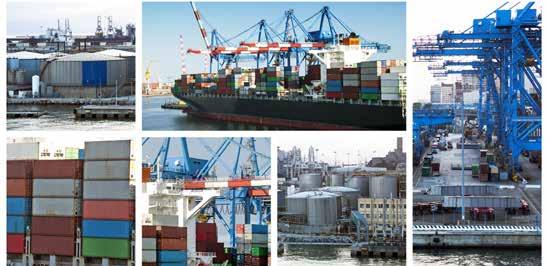
31 minute read
Annual Port Review
PORTS CONTINUE TO PERFORM DESPITE PANDEMIC CHALLENGES
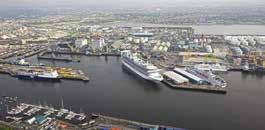
There’s no getting away from the fact that Ports around the country have been seriously challenged this year because of the lockdown to battle the Covid-19 global pandemic.
The economy on both sides of the Irish border has understandably taken a huge hit since March, but Ports such as Dublin, Belfast, Warrenpoint, Larne and Rosslare have been playing a crucial role in preserving the supply chain. Ports have had to adapt their normal working
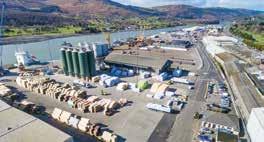
arrangements in order to safeguard staff and their families, while the vital contribution of port workers, hauliers and ships crews to keep trade flowing and businesses functioning cannot be overstated. For many, 2020 was shaping up to be another record breaking year with increasing trade and investment in facilities. Many plans have been put on hold, but our ports are all in reasonable health to withstand the present pressures, and while no one is denying 2021 will also be a difficult year, in the words of a wellknown song from the past, ‘we will survive.’ In this annual review, we take a look at how our ports have been performing over the past year, and what plans they are making for the future.

WARRENPOINT PORT LOOKING TO THE FUTURE WITH CONFIDENCE
There is a buzz of industry and an air of cautious optimism as you walk around a new look Warrenpoint Port. The ‘Six Acre’ investment Project, as it was known, has enabled the Port to create a 10% increase in operating space within the existing 60-acre footprint. It makes the facility, located midway along the economic corridor between Dublin and Belfast, almost unrecognisable from just 12 months ago, with swaths of new space created.
The £1.4 million recent capital expenditure is clearly visible with new internal roadways; redundant buildings coming down; and new plant and machinery; as well as a busy quay wall with the regular Seatruck RoRo and some other interesting vessels. Like many other organisations the last 12 months have been somewhat challenging for the Port, but under the stewardship of new CEO David Holmes, who has been in position since August 2019, the Port is reorganising and building for the future. Export and Freight caught up with David Holmes to chat about the year just past and his plans for the future. “It has undeniably been a completely unpredictable year. We had some real positives to look back on but obviously the impact of Covid-19 has had implications right across the board. We are however, already starting to see green shoots again. Volume dropped by 20% during Covid-19 lockdown. Primarily driven by pent up demand however, the recovery in July and August has been significant and this is very positive news.”
Niche Markets
“2019 was very good for volume; overall unitised cargo increased by 6.3% but overall tonnage was down slightly to 3.5 million tonnes. We had the opportunity to handle some interesting project cargo including wind turbines. This is not the first time we have been a port of choice for

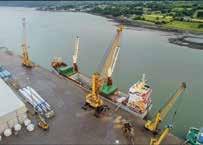
unusual loads and we have invested in making it a niche market that we should be attractive in. “In 2018 we purchased a new crane followed up by the modernisation of our two existing cranes in 2019. This has given us fantastic increased cranage capacity. With the wider investment in the site we have also created more space and we have invested in our plant; with 10 new forklifts and three new combi-lifts. This sets us up well to be highly competitive and appealing in specialist markets.
Capex
“A major element of our recent capital expenditure investment, totalling £1.4m, is Brexit readiness preparations. Government needs to provide clarity on the likelihood of the requirement for Brexit Inspection Centres as this will present challenges, especially in relation to timescale. Our Brexit Readiness planning has created the space to accommodate such a facility however, so we are confident we can rise to these challenges. “We are forging on, making our systems, processes and procedures leaner, and better equipped. We have already mentioned our investment in new internal roadways, in removing redundant buildings as well as in plant, machinery and cranage. “The management team also moved into new administration facilities at the Town Dock Office in Warrenpoint town centre following a major investment to create the new space. This ties in with our move to forge stronger relationships in the locality.
Engagement
“We are engaging more with our workforce to ensure everyone understands our objectives. This helps us to invest in a team that understands our customers’ requirements and has the capacity and flexibility to meet those demands. We undertook a significant
upskilling and training exercise early in 2020 which has been extremely beneficial. “I would like to sincerely thank our team. They have made me feel so welcome since I arrived last year and as frontline workers, they really stepped up to the challenges faced during the pandemic. Warrenpoint Port has also recently embarked on a new Community and stakeholder engagement programme called ‘On Board’ which will be rolled out over the next 12 months. The aim of the programme is to build stronger relationships in the local community; and to look at how the industrial nature of the Port can co-exist with tourism etc. at its edge of town site in an area of outstanding natural beauty.
Trade
“Warrenpoint Port handles circa 12% of Northern Ireland’s port activity, with 45% export and 55% import. The island of Ireland experienced a drop off in demand for animal feed in 2019 due to a good local crop and this impacted on imports. Demand for timber was also down slightly, but 2019 saw a significant increase in steel imports at Warrenpoint Port. This was up 52% and coincided with a wider economic boost at the time, due to many large commercial projects across the island. In terms of exports, cement was fairly steady, after experiencing a significant uplift in 2018. This market has peaks and troughs and is likely to change again as we move through 2020 and beyond.
David Holmes
Warrenpoint also continued to deliver strong demand for the environmentally important export services for recycled material and RDF- Refuse Derived Fuel; particularly for Re-Gen Waste, a major recycling firm local to Warrenpoint Port. “The Nippon Gases CO2 storage facility continues to progress, with completion expected by the end of 2020. In the interim, due to an increase in demand for food grade C02 across the island, the needs are being met by a CO2 tanker ship docked in Warrenpoint Port. This signals a major investment by Nippon Gasses in Warrenpoint and indeed on the island of Ireland.
Looking ahead
“Brexit, combined with the challenges of Covid recovery and the impact both have on the economy, will continue to shape the remainder of 2020 and beyond. There is no doubt of that but that is merely an impetus for us at the Port to ensure we are leaner, fitter and well prepared for whatever 2021 and beyond might bring our way. “The Southern Relief Road, currently at feasibility stage, would see a direct link made to the A1 dual carriageway linking to the M1 motorway to Dublin and Belfast. It continues to represent a key piece of infrastructure for us and the area. “The message from Warrenpoint Port and from me and my team looking ahead is very clear. We are open for business, we have capacity, capability and we have a fine-tuned operation aligned to our customer demands and requirements. “Our increased capacity in terms of space creation, investment in plant, equipment and people creates a competitive offer, demonstrating we are building for the future and we are progressive. We are forward thinking, well organised and we are ready for the next stage in our growth trajectory.”
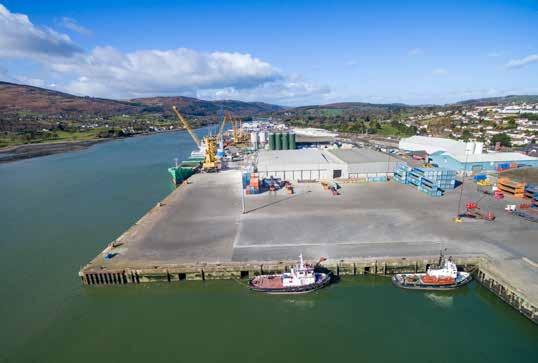
P&O FERRIES KEEPING TRADE FLOWING ACROSS THE IRISH SEA & BEYOND
From the start of this pandemic, P&O Ferries’ aim has remained the same: to keep its customers and employees safe and provide support wherever it can. And despite facing some of the most significant challenges the industry has ever had to grapple with, P&O Ferries have successfully and safely continued operating.
The company has been able to ensure the smooth movement of some of the UK’s most vital imports, such as medicines, cleaning products and food, during a period of unprecedented supply chain disruption across the globe. P&O has been able to continue to deliver best in class services to its customers by listening and swiftly reacting to their needs. In Northern Ireland, one of the central ways the company adapted to growing customer needs was through an expansion of its sailing schedule on its Larne to Cairnryan route in June and later in August. Building on this momentum, and a desire to consistently deliver on customer needs, P&O also introduced a fourth ship on its Liverpool – Dublin route in early July. The company says it is pleased and encouraged by the way in which these actions have been welcomed. P&O’s speedy Larne to Cairnryan crossing takes just two hours, making it the most efficient way to ship freight to and from Scotland. Its fleet on this route includes two of the company’s fastest 21,000-ton freight ships, the European Causeway and its younger sister, the European Highlander.
Increased Sailings
In June, it became clear to P&O that its customers on this route were facing increasingly tighter deadlines as countries around the world began the crucial work of restarting their economies. Moving swiftly on concerns raised by customers, P&O Ferries expanded the sailing schedule and now offers up to

six departures a day in each direction. This regular daily service has long provided a bridge for goods being transported between Northern Ireland and the Republic of Ireland to Britain, and with their increased schedule, P&O aims to support customers navigating a landscape markedly determined by the status of COVID-19 to operate in a smart and agile fashion. P&O Ferries’ Dublin to Liverpool route enables customers to move goods between two important cities in only 8 hours. Operated by a fleet of robust ships, including Norbay, its ROPAX ship, the route is part of a critical supply chain that handles products needed in the medical and healthcare sector, food industry, and for energy generation. In July, following calls to increase its freight capacity on the route, P&O introduced MISIDA, a new ship that now allows the company to offer up to four daily return crossings for freight. With a fourth ship, P&O can now offer an additional sailing leaving Liverpool at 16:00 Monday to Friday, and Dublin at 03:00 Tuesday to Saturday. P&O hopes that this additional freight capacity will alleviate customer concerns regarding a supply chain that is central to trade in the UK, Ireland, and continental Europe.
Adaptability
P&O Ferries are committed to maintaining a healthy and sustainable business that will continue to grow as an important strategic asset for the UK, helping families and freight move easily and affordably between Britain, Ireland, and continental Europe. Its operations on the Irish Sea are central to delivering such a future. The aforementioned changes highlight P&O’s ability to adapt and respond to customer needs as we all continue to respond to the ongoing challenges posed by the COVID-19 pandemic in the region and beyond. They also ensure that, as a business, P&O Ferries can operate in the Irish Sea in a safe and supportive manner and deliver on its aim to keep customers and employees safe.
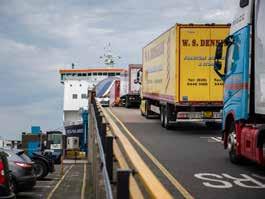


pofreight.com
PORT OF LARNE THE PREFERRED GATEWAY FOR MANY
Many hauliers prefer the Port of Larne for a number of reasons, not least because of its easy access into and out of the harbour, and the fact it is only a short two hours sailing time away from Scotland.
With regular crossings
provided by P&O Ferries between Larne and Cairnryan, enabling you to schedule freight movements at times that will best suit you, from early morning onwards, lorry drivers can spend less time onboard and more time on the road. Responsible for all marine and many quay side operations is Harbour Master Stuart Wilson, appointed to the role late last year; he is also the Designated Person under the Port Marine Safety Code. Stuart has over 30 years experience in the Marine Industry, in a number of related fields. Having qualified and worked as a Deck Officer with BP Shipping, he went on to gain an honours degree in Maritime Studies at Cardiff University. He consequently worked in port management, stevedoring, ferry and terminal operations, ship management, marine bunkering and ship repair, before becoming Deputy Harbour Master in the Port of Belfast and subsequently became Harbour Master in Larne Port. His broad knowledge of the shipping industry, as well as his collaborative and solutionfocussed approach, enables
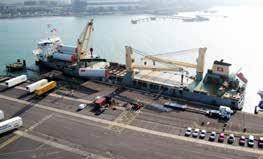
him to appreciate and facilitate the various requirements and needs of port customers, users and service providers. Like all ports, Larne has had to meet the various challenges caused by the Covid-19 pandemic, and comments Stuart: “It has
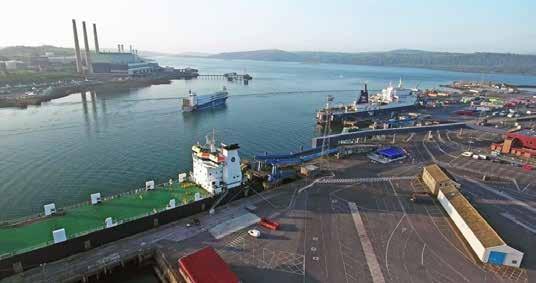
been ‘business as usual’ in so far as we have been able to provide an essential service to our customers, prioritising those working in key areas on the front line, while protecting and safeguarding all who are employed within the harbour area.” Larne, of course, has become a gateway of choice for many freight operators exporting to and from Ireland, with facilities at the port including nearly 5000 sq metres of warehousing and generous storage areas within its 40 acres site.
Diverse Services
“While we face competition from our near neighbours Belfast, we do offer a diverse range of services, being a deepwater port,” says Stuart. “Our core business has always focused on ro-ro operations, but in more recent times the port has been opened up to a whole range of diverse
cargoes and has expanded its capacity to handle project cargo.” The port has enjoyed, for example, good success in handling onshore windfarm components such as turbines. Indeed, the variety of heavy and outsized cargoes handled at Larne is impressive and ranges from piling rigs and construction plants to excavators, wind turbines and even railway carriages. It also acted as the mobilisation port for the seasonal repair work on the interconnector cables running between Northern Ireland and Scotland. In more recent years, too, the port, which holds a license for the storage of Solid Recovered Fuels and scrap steel, has attracted a number of bulk ships, general and project cargo ships to the harbour.
Safe & Secure
With P&0 Ferries’ extensive parking available, the port, which is just 30 minutes from Belfast and two and a half hours from Dublin, handles around a quarter of a million commercial vehicles each year – and it is also fully equipped to accept unaccompanied traffic. Dockside staff are fully trained to load all types of trailers ensuring a safe and secure passage. The port, of course, is also well established in handling driver accompanied traffic, with fast and efficient check-in facilities dedicated to serve freight drivers. The port is nine nautical miles closer than Belfast to Scotland and adds Stuart: “As the shortest Irish Sea crossing, which is one of the competitive advantages enjoyed by P&O Ferries at Larne, ferries can operate reliably and recover quickly after any weather-related disruption. “Additionally, being at the end of the recently upgraded A8, we have dual carriageway right to the port gate, which has also improved the port’s inland connectivity.” As we mentioned, with much improved infrastructure in recent years, including modern freight drivers’ facilities, it has become even more easily accessible for local companies who may not have considered using the facilities in the past and indeed that is proving to be the case. There’s little doubt, the Port of Larne, with its highly competitive rates, proactive attitude and safe working environment, clearly makes a great choice for project cargoes, bulk cargoes and, of course, passenger traffic.
Stuart Wilson, Harbour Master at Larne Port.
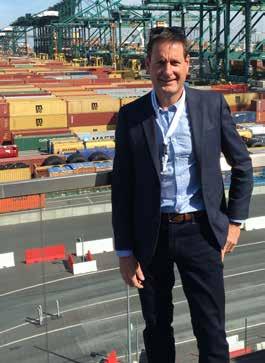
OUR CORE BUSINESS HAS ALWAYS FOCUSED ON RO-RO OPERATIONS, BUT IN MORE RECENT TIMES THE PORT HAS BEEN OPENED UP TO A WHOLE RANGE OF DIVERSE CARGOES AND HAS EXPANDED ITS CAPACITY TO HANDLE PROJECT CARGO
LARNE PORT
Whatever your port services requirement, we’re HERE TO SERVE!! Call Roger Armson or Stuart Wilson on +44(0)2828872100 or email: info@portoflarne.co.uk, to discuss how we can help you.
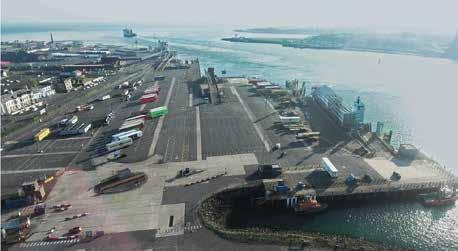
Dublin Port Company continues major long-term investment programme
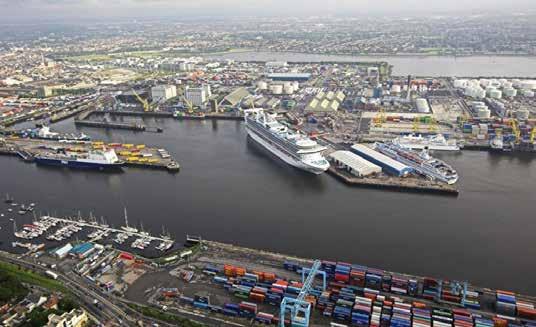
Dublin Port Company has reported its second quarter trading figures for 2020, showing a decline in overall port tonnage of -10.9% in the first six months of the year.
Having seen a decline of -4.8% in Q1 (which had been attributed to Brexit stockpiling in the first quarter of last year), there was a further and steeper decline in Q2 of -17.0% as the Covid-19 pandemic impacted on the country. The Q2 decline of -17.0% was less than had been feared following a decline in the month of April of -26.2%. This was followed by a smaller decline of -20.5% in May and by a decline of just -5.5% in June. Unitised trade (trailers and containers combined) fell by -13.5% to 321,000 units during Q2 with Ro-Ro declining by -13.0% to 225,000 units and Lo-Lo by -14.0% to 173,000 TEU. Imports of new trade vehicles through Dublin Port in the April to June period decreased by -64.9% to 9,900 and a significant decline appears inevitable for the rest of the year. Bulk liquid volumes, primarily petroleum products, declined by -37.8% to 715,000 tonnes. Aviation fuel accounts for more than one-fifth of all petroleum imports in Dublin Port and the impact of Covid-19 on air travel has greatly reduced demand. Bulk solid commodities declined by -20.6% to 388,000 tonnes. Likewise, reduced car traffic during the lockdown has greatly diminished demand for petrol and diesel. Ferry passenger numbers, too, decreased by -78.2% to 120,000, the great majority of whom were HGV drivers, critical supply chain workers. The number of tourist vehicles fell even further, by -84.2% to 24,000. There were no cruise ship calls to Dublin Port in Q2 and none is anticipated for the remainder of the year.
Less Than Feared
Commenting on the results, Dublin Port’s Chief Executive, Eamonn O’Reilly, said: “The Q2 decline of 17.0% in cargo volumes was less than we had feared it might be. After the first six months of the year, our volumes are down by 10.9%. At this level, our throughput for the full year would be back to where it was in 2016. “We saw after the 2008 recession how rapidly the Irish economy can recover from a deep recession and we seem to be seeing some evidence of this resilience in recent months where a 26.2% fall off in April was followed by a smaller decline of 20.5% in May and by a decline of just 5.5% in June. “Even during the rapid and deep downturn during Q2, we have seen new unitised services – both Ro-Ro and Lo-Lo – introduced on routes to Rotterdam, Santander and Liverpool and additional capacity added on existing services to Liverpool. We are able to accommodate these because we have been systematically adding to port capacity in recent years.” He added: “We recently received a 15-year planning permission for the MP2 Project. This will allow us to accommodate the future needs of Ro-Ro and Lo-Lo lines in the years ahead. Given that we have been playing catch-up over the past decade to provide additional port infrastructure for future growth, the drop back in volumes this year gives us some breathing space and it is important that we do not waste the opportunity this gives us to make counter-cyclical investment in port infrastructure. “The MP2 Project planning permission is for 937 metres of new berths, including an extension to an existing berth. This will allow us to develop 1,117 metres of berths for unitised trade at the eastern end of the port, split 50 / 50 between Lo-Lo and Ro-Ro. “Dublin Port has two oil jetties through which almost one third of the country’s total energy requirements are imported in the form of petrol, diesel, kerosene and aviation fuel. The MP2 Project planning permission allows for the redevelopment of one of these jetties to provide an additional berth for container ships as and when the demand for fossil fuels permanently reduces in response to national climate change policies. “The MP2 Project is the second of three Strategic Infrastructure Development projects needed to realise the vision of Masterplan 2040. Work on the first of these – the ABR Project – is well underway. The additional port capacity which these projects will give contributes substantially to the Masterplan’s objective to provide additional port capacity to bring Dublin Port to its ultimate capacity by 2040.”
IRISH FERRIES FREIGHT

IRISH FERRIES FREIGHT
GETTING NORTHERN IRELAND’S ECONOMY BACK ON TRACK
2020 has been a year like no other, testing the resilience of the port industry, and that of our customers and their supply chains, writes Michael Robinson, Port Director, Belfast Harbour.
I believe that the sector has collectively risen to the unparalleled challenges COVID-19 has posed to all of us, and I will never forget the determination and skills of the wider port and transport community to successfully mitigate the impact of the pandemic. No doubt, COVID-19 has been significantly disruptive and its impact is still unfolding. Business and consumer confidence have been shaken and after early declines in some sectors of almost 90%, volumes have begun to recover as lockdown has been eased and throughput in the last few months has been c.10% down from 2019 levels. The worst impacts have been in our cruise, tourist and leisure activities which have all but ceased operation with only one cruise ship calling in Belfast this year when we were expecting to receive over 125. Belfast Harbour, however, has a long-term strategy which – despite the pandemic – still charts a course for future growth. They say that no plan survives contact with reality, and adaptations will certainly be required, but our 2035 ‘A Port for Everyone’ strategy remains our guiding star. Our ambition is that Belfast becomes the best regional port in the world, cementing our role as a gateway to the world for our importers and exporters, and a hub for economic growth. This will include further developing Belfast Harbour as a key economic hub for the region by investing in marine infrastructure, SMART technologies and green initiatives that support society’s drive to decarbonise.
Investment Plans
In the past 10 years we have invested over £290m in port infrastructure and wider estate regeneration. During 2019, more than £50m was invested in the port’s container terminal and to upgrade the ramp and facilities at the Belfast -Liverpool ferry terminal in readiness for the introduction of the larger new Stena Line vessels serving that route. In doing so, we have made the largest ever investment in a single piece of port equipment, the new £6.6m Liebherr ship-toshore container handling crane and it will soon be joined by a ‘sister crane’ which has recently delivered to the Port. These new cranes and the automated Rubber Tyre Gantry (RTG) cranes in the terminal support our SMART Port agenda and will make the terminal safer, more efficient and will increase its handling capacity by 30%. We have also recently committed £116m in further investment in strategically significant marine and estate projects. These investments will be a critical enabler of Northern Ireland’s COVID-19 recovery, given the Port’s recognised role as a key driver of the regional economy. Achieving our ambitions will require close collaboration with key customers such as Stena Line. We acknowledge that the scale of the vision we have set ourselves can only be achieved if we harness our efforts with likeminded customers and stakeholder groups.
Trading & Financial Performance
Success also lies in having the financial capacity to make the necessary investments and that rests upon the continued successful trading performance of the port. Fortunately, due to our Trust Port status, which enables us to reinvest all profits back into developing the port and harbour estate for the benefit of customers and wider economy, and as result of the diverse range of business activity inside our estate, we are starting from a strong base. Before the lock-down took effect in March, we were reviewing what a strong year 2019 had been for trade through Belfast Harbour. Tonnage handled was above 24m tonnes for the second year running with particularly positive figures for Ro-Ro, containers and exports of aggregates. Based on these strong trading figures we also reported a sound financial performance for 2019 in line with expectations. This will enable us to respond to the challenges posed by the impact of COVID-19 on the local and global economy. Turnover in 2019 was £65.9m (down 4%) and generated operating profits were £30.6m (down 15% from the record results of 2018). The decline in earnings largely reflected the completion of a major offshore windfarm contract mid-2018. Ro-Ro traffic rose by 4% to a record 542,000 units, reflecting the success of continued investment by Stena Line and Belfast Harbour in vessels and RoRo terminals respectively while container traffic increased by 2%, surpassing the 130,000 units handled threshold for the first time since 2008. Stone exports by Co Down based Conexpo

for GB and European infrastructure projects exceeded 1m tonnes for the first time, whilst tonnages in the wider aggregates sector grew by 4% to a record 1.6m tonnes. Of course, not every trade sector grows every year and 2019’s better weather led to lower imports of grain, animal feeds and fuels. Indeed, over the longer-term, the mix of trades handled by the port will continue to evolve as our economy and consumer spending habits change. What long-term impact COVID-19 has on our economy is still to be determined, but it is not difficult to envisage an acceleration in the drive to decarbonise society. We had already factored in a continued decline in fossil fuel imports, a staple of the port industry for the last century, but believe this presents an opportunity to further develop trades related to the green economy such as offshore wind where Belfast Harbour has a proven track record and to support the development of other new fuel sources such as Hydrogen. The scale of the challenge to get the economy back to pre-crisis levels, particularly the recovery of tourist and leisure trades, will be immense. Brexit uncertainty is an unhelpful additional uncertainty, but we are continuing to work with both local and national Government, to identify what the full outworking of the NI Protocol will be and how we, our customers and terminal operators, can facilitate its implementation with minimum disruption so as to continue to position Belfast as the leading transport hub in the region. Belfast Harbour’s immediate goal is to play its part in getting Northern Ireland’s economy back on track. 2021 will be challenging, but our sound finances, ambitious investment plans and our commitment to work with others for mutual success, provides a good platform from which to start.
Stena Line adds Freight capacity to Belfast Routes
Stena Line has chartered the RoRo vessel Seatruck Panorama to help boost freight capacity on its Belfast to Liverpool and Belfast to Heysham routes.
Following the dramatic COVID related drop in freight volumes, Stena Line was forced to remove one freight ship from its Belfast hub which resulted in reduced capacity and frequency. During the summer months, Stena Line has seen an increase in freight demand and anticipates that extra capacity is required for the traditionally busy Autumn period as well as the expected increase in pre-Brexit trade activity. Paul Grant, Stena Line Trade Director (Irish Sea) said: “Adding a seventh ship to our Belfast operations will help us increase frequency, capacity and give us greater operational flexibility. This extra ship will be capable of operating to Liverpool and Heysham thus ensuring that we can better match demand and the needs of customers. It has been a very challenging time for the freight industry, but we are confident that having additional capacity available on these important trading routes between England and Northern Ireland will help us provide an enhanced sailing schedule for our customers.” The freight-only ship is expected to make 10 sailings weekly between Belfast and Liverpool/ Heysham. The addition of Panorama on the Northern Ireland to England corridor will increase freight capacity by 28% and frequency will rise from 46 to 56 crossings weekly compared to the present. In January 2021, Stena Line will further boost freight capacity when it adds the newly built Stena Embla to its Belfast – Liverpool service. Stena Embla will replace the smaller Stena Mersey and will join its sister ship Stena Edda and Stena Estrid in what is a
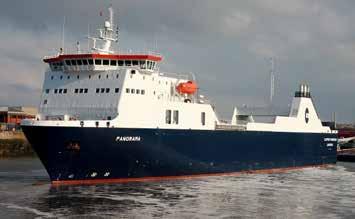
significant upgrading of freight and passenger services across Stena Line’s Irish sea routes. Paul Grant added: “Despite all of the challenges we and our customers are facing, Stena Line continues to develop its Belfast business hub with these exciting additions to our fleet. Stena Line remains committed to support the freight industry to the best of its abilities as it has done throughout the Coronavirus pandemic to date, helping to keep vital supply lines open.”
Stena Line reduces CO2 ten years ahead of emissions’ targets
Despite a tough situation for the ferry industry due to COVID-19 Stena Line continues its sustainable journey. In the newly published sustainability overview Stena Line presents initiatives, improvements and challenges within the sustainability area as well as give account on the company’s ambitious sustainability targets.
Engine Room Crew.

During 2019 Stena Line to reduce CO2 emissions and is international shipping targets for reducing emissions. The company reduced the total CO2 emissions with 1,7 %, corresponding to 24 000 tonnes of CO2 in total. Even more important is that Stena Line continued to improve the efficiency and reduced the emissions per transported ton freight and passenger vehicles onboard the vessels with 3,6% CO2. This means that Stena Line, ten years ahead, already meets the International Maritime Organisation (IMO) targets for 2030 of a 40 % reduction in CO2 emissions efficiency from 2008-2030. “We aim to be the leader in sustainable shipping and we have high ambitions. During the last ten years we have improved the efficiency with more than 320 energy efficiency actions onboard and onshore, both technical and operational improvements and investments. The introduction of AI assisted vessels and the delivery of our first new larger and energy efficient vessels that went into operations on the Irish Sea during
now ten years ahead of the the spring, are some highlights from last year”, says Erik Lewenhaupt, Head of Sustainability at Stena Line. The largest challenge for the shipping industry as a whole and for Stena Line is to reach zero emissions by 2050, in line with international targets. “We are currently working in parallel with reducing fuel consumption, and emissions to sea and air and at the same time exploring and evaluating the fuels for the future. We are currently involved in several projects with alternative fuels and propulsion, including the world’s first methanol powered vessel and a battery project with the aim of launching a fully battery powered vessel before 2030”, says Erik Lewenhaupt, Head of Sustainability at Stena Line.
IVECO Launches New Deals on Stralis Heavy Trucks
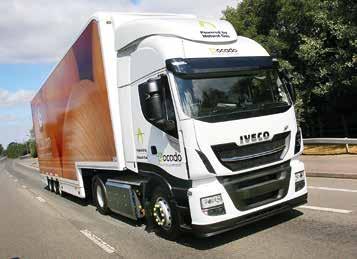
As lockdown measures continue to gradually relax, businesses can begin to restart and rebuild their confidence.
IVECO are ready to lend a helping hand with new offers on the Stralis heavy truck, designed to keep our haulage heroes rolling without breaking the bank. With immediately available stock, operators can reap the benefits of running a brand new, powerful and efficient truck now, with the option to halt their vehicle outgoings for six months. Longer term, the included 5-year Repair & Maintenance contract will ensure complete peace of mind, supported in 36 European countries by the IVECO Assistance Non-Stop programme and the UK’s 89-strong service network. To take advantage of this offer, vehicles must be ordered before 30th September 2020 and registered before 31st December 2020. “Stralis has proven itself to be a strong and reliable business partner, with the Natural Power being a real game-changer for those with a greener interest,” commented IVECO Truck Business-line Director, Gareth Lumsdaine. “The inclusion of the R&M contracts ensures that customers can relax knowing that our dealer network is behind them to care for their vehicles properly whilst protecting their resale value.”
iGurt - the intelligent Cargo Restraint System
Transport damages caused by poorly secured freight are routine in the transport business; serious accidents and damages to the load frequently occur due to swaying or unstable trailers.
BPW is now tackling one of the main causes with the intelligent cargo restraint system, iGurt, which checks and fully documents the tension of the lashing straps throughout the entire transport process. Loose cargo is estimated to be the cause of 20 to 25 per cent of traffic accidents in heavy-load traffic. The iGurt aims to reduce this amount by providing a system that tracks the restraint through permanent status monitoring. All the devices in use display the respective preload force on the housing unit. It also provides information on excessive preload force, which might damage a susceptible load. The iGurt device is fastened easily and securely to each lashing strap. If a strap becomes loose, drivers receive an alert on their iGurt smartphone app via Bluetooth, and prompt action can then be taken. Operators have the option to integrate the iGurt with their existing BPW idem telematics system. In this case, a warning signal is sent to both the driver and the operator’s allin-one platform, Cargofleet 3. The sturdy, shockproof housing is designed for long-term use on the trailer. The battery charge lasts for around one year, while the battery itself can be replaced quickly and easily.
Carrier Transicold has introduced three new transport refrigeration units into the UK and Ireland, delivering significant operational and environmental benefits for truck, trailer and light commercial vehicle fleets.
The new models include the first PIEKcertified version of its flagship Vector HE 19 (High Efficiency) trailer unit, which will now operate below 60 decibels, the equivalent of normal conversation, in either a mono or multi-temperature configuration. “Our new PIEK-compliant Vector HE 19 takes quiet-running to a new level, being perfect for fleets making frequent nighttime deliveries to stores in residential areas,” said Scott Dargan, managing director, Northern Europe, Carrier Transicold. Carrier Transicold has met these strict PIEK levels whilst packaging the new system within the regular Vector HE 19 chassis. The previous generation PIEK-certified Vector 1950 City had its diesel engine housed in an insulated cabinet underneath the trailer. Available now, the new PIEK-certified Vector HE 19 is an addition to the range, offering operators the same 10% reduction in weight, 19% reduction in energy consumption and up to 30% reduction in fuel consumption versus the previous generation Vector 1950. Also debuting in the UK and Ireland this year will be the new Xarios 8 refrigeration system which is ideal for the larger rigid truck market. The Xarios 8 unit has improved efficiency and a third more cooling capacity compared to the current Xarios 600, along with a very low refrigerant charge, a new evaporator ventilation motor and brushless condenser ventilation system to reduce wear on parts, and lower maintenance costs. Additionally, its shell is manufactured by injection moulding, reducing manufacturing steps and improving the build process. The third new model Carrier Transicold will bring to market is the Neos HE 100 S for light commercial vehicles. This electrically driven system optimises energy consumption, while maintaining a cooling capacity and look almost equivalent to the standard Neos 100 S system. The unit features new technology, enabling a 35% reduction in energy consumption to 58 amps. It also offers precise temperature control of an insulated load space, varying in size from two to 6m3.










